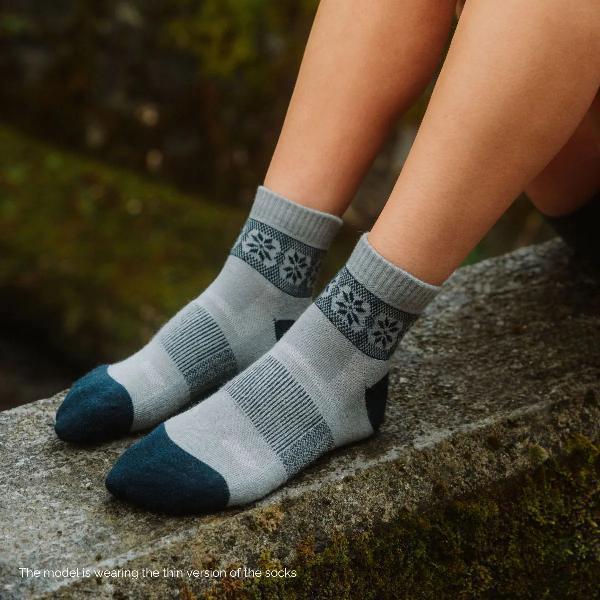How do merino wool socks perform in wet conditions?

Strong 8k brings an ultra-HD IPTV experience to your living room and your pocket.
Choosing the right socks is essential, especially in wet conditions where comfort, warmth, and foot health are critical. Merino wool socks have gained popularity for their unique properties that make them suitable for such challenging environments. This article delves into how merino wool socks perform in wet conditions, exploring their benefits, comparison with other materials, and tips for care and maintenance.
Properties of Merino Wool
Merino wool is renowned for its natural insulation, which helps keep feet warm in cold conditions and cool in hot conditions. Its fibers are exceptionally fine, making it soft and comfortable against the skin. Merino wool is also breathable, allowing moisture to escape and preventing feet from becoming clammy. One of its most significant properties is moisture-wicking; it can absorb moisture from the skin and release it into the air, keeping feet dry. Additionally, merino wool is durable, maintaining its shape and integrity even after repeated use and washing.
Performance of Merino Wool Socks in Wet Conditions
In wet conditions, merino wool socks perform exceptionally well due to their ability to absorb and retain water without feeling wet. They can hold up to 30% of their weight in moisture before feeling damp, which helps keep feet dry. The thermal regulation properties of merino wool ensure that feet stay warm even when the socks are wet, as the wool fibers trap heat effectively. The drying time of merino wool is relatively quick compared to cotton, further enhancing its suitability for wet environments. Furthermore, merino wool has natural antimicrobial properties, which help control odor, making these socks an excellent choice for prolonged use in wet conditions.
Comparison with Other Materials
When compared to synthetic fibers, merino wool stands out for its natural properties. Synthetic fibers like polyester and nylon are often used for their quick-drying capabilities and durability, but they lack the natural insulation and moisture-wicking abilities of merino wool. Cotton, while comfortable, absorbs water quickly and dries slowly, making it less suitable for wet conditions. Blended materials may offer a compromise, combining the quick-drying properties of synthetics with the comfort of natural fibers, but they still often fall short of the unique benefits offered by pure merino wool.
Benefits of Merino Wool Socks in Wet Environments
Merino wool socks provide unparalleled comfort and warmth in wet environments. Their ability to regulate temperature and wick moisture away from the skin helps prevent blisters and other foot health issues commonly caused by prolonged exposure to wet conditions. Whether hiking, running, or engaging in everyday activities, merino wool socks offer a level of comfort and protection that other materials struggle to match. The natural elasticity of merino wool also ensures a snug fit, reducing friction and enhancing overall foot health.
Care and Maintenance of Merino Wool Socks
Proper care and maintenance are crucial to extend the life of merino wool socks. They should be washed in cool or warm water using a gentle detergent to prevent damage to the fibers. Air drying is recommended, as high heat from dryers can shrink the wool and reduce its effectiveness. Storing merino wool socks in a cool, dry place helps maintain their shape and integrity. With proper care, merino wool socks can last for years, providing consistent performance and comfort.
User Experiences and Reviews
Outdoor enthusiasts and athletes frequently praise merino wool socks for their performance in wet conditions. Many users highlight the socks' ability to keep feet dry and warm during extended outdoor activities. Expert opinions also support these claims, emphasizing the natural properties of merino wool that contribute to its superior performance. Testimonials often mention the long-lasting comfort and durability of merino wool socks, making them a preferred choice for those who frequently encounter wet environments.
Conclusion
Merino wool socks offer numerous advantages in wet conditions, making them an excellent choice for anyone seeking comfort, warmth, and foot health. Their natural insulation, moisture-wicking properties, and quick-drying capabilities ensure that feet remain dry and comfortable even in the most challenging environments. Compared to other materials, merino wool stands out for its unique combination of benefits. Proper care and maintenance can extend the life of these socks, ensuring they remain a reliable choice for years to come. Whether for hiking, running, or everyday use, merino wool socks provide a level of performance and comfort that is hard to beat.
FAQs
How do merino wool socks compare to cotton socks in wet conditions?
Merino wool socks outperform cotton socks in wet conditions due to their moisture-wicking properties, quick-drying capabilities, and ability to retain warmth even when wet. Cotton absorbs water quickly and dries slowly, which can lead to discomfort and foot health issues.
Can merino wool socks be worn year-round?
Yes, merino wool socks can be worn year-round. Their natural insulation properties keep feet warm in the winter and cool in the summer, making them versatile for various weather conditions.
How should merino wool socks be washed?
Merino wool socks should be washed in cool or warm water using a gentle detergent. Avoid using high heat when drying, as it can shrink the wool. Air drying is recommended to maintain their shape and effectiveness.
Are merino wool socks suitable for people with sensitive skin?
Merino wool is softer and finer than regular wool, making it suitable for people with sensitive skin. Its natural fibers are less likely to cause irritation, providing a comfortable wearing experience.
Do merino wool socks help prevent blisters?
Yes, merino wool socks help prevent blisters by wicking moisture away from the skin and reducing friction. Their snug fit and natural elasticity also contribute to minimizing the risk of blisters.
Note: IndiBlogHub features both user-submitted and editorial content. We do not verify third-party contributions. Read our Disclaimer and Privacy Policyfor details.


